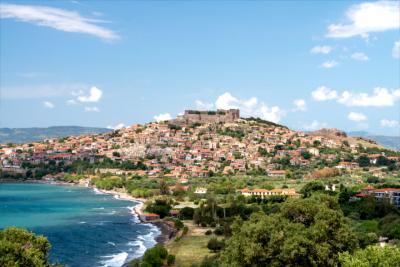Travel Offers
Travelmyne Featureprint
Distance
Lesbos - Nature and Culture in Harmony
While the cities and towns are always vibrant with activity, travellers find tranquillity and relaxation in the villages. Lesbos does not only offer an abundance of cultural sights but also numerous volcanic calderas with thermal springs and an impressive avian fauna.

Geography - The third biggest Greek island
Lesbos (also called "Lesvos") is a Greek island in the North Aegean and lies near the Turkish coast (9 km away at the closest point). It has an area of about 1,634 km² and about 86,500 inhabitants. It is the third biggest island in Greece after Crete and Euboea. Its capital is the city of Mytilene. Other important destinations are Petra, Mithymna, Eressos and Agiossos. Lesbos is a volcanic island and has over 30 lava domes, most of which are located on its western side. These are also referred to as "necks". In addition, there are several volcanic calderas, for example Skoutari, Vadousa and Agra. You also find volcanic activity on the island's eastern side. Polichnitos accommodates the hottest spring in Greece (70 to 85 °C). The climate on the island fluctuates and the day and night temperatures differ considerably. Precipitation fluctuates as well. The reason for this is the island's geographical position. It lies in the transition zone between the Mediterranean winter rain climate and the continental steppe climate.

Nature - A real bird paradise
Although the landscape in the west of the island looks desert-like, Lesbos is a very green island because its east is covered in forests. A real highlight is the petrified forest between Antissa and Sigri. It was created by volcano eruptions about 23 million years ago, which isolated the plants from their surroundings, thereby protecting them from decay. Of course, Lesbos also offers wonderful beaches with crystal clear water. Some of them are Vatera, Skala Sikamia, Skala Eressou and Mithymna. The island is also known for its impressive avian fauna. The biotope of Polichnitos is home to over 100 bird species such as swans, cormorants, flamingos, ibises, white storks, willow ptarmigans, curlews, herons and coots. In addition, there are numerous reptiles, amphibians and mammals. The biotiope's flora is equally fascinating. It is vegetated by oaks, wild olive, walnut, pistachio, almond and fig trees, wild roses, mint, lemon balm, aniseed, chicory and many more.

Culture - A Roman Aqueduct and many museums
Around 400 BC, the Greek poetess Sappho sang about love between women, which gave the island its name. The modern term "lesbian" is derived from this name. That is why Lesbos is a destination for many lesbians, especially the village of Eressos, which is Sappho's birthplace, according to legend. Significant museums are the Natural History Museum of the Lesvos Petrified Forest in Sigri, the Teriade Museum and the Teriade Library and the Museum of Modern Art. Other interesting museums are the Museum of Costumes and Embroidery, the Old House, the Museum of Folk Art and Craft as well as the Archaeological Collection of Mithymna. Admirable buildings are the Monastery of Limonos, the Saint John Monastery as well as the fortresses of Mytilini, Mithymna and Sigri. The island generally offers an abundance of cultural assets and attractions. Examples are the amphitheatre in Mytilini, the pilgrimage destination of Klopedi, the ancient municipality of Thermi and the Early Christian Basilica of Chalinados. Highlights are the Statue of Liberty in Mytilini and the Roman Aqueduct of Moria.

Experience - Visiting thermal springs and watching birds
Besides the thermal spring in Polichnitos, there are other thermal springs in Thermi, Therma, Agios Ioannis and Eftalou which are all waiting to be discovered. Caves are popular destinations as well, for example the caves of Magaris, St. John and St. Bartholomew. Thanks to the diverse avian fauna, Lesbos is a great destination for watching birds, which is possible throughout the year. Many regions are equipped with signposts which show you where to find birdwatching posts. Important areas are the bays in Kanolli, Eressos and Dipi as well as the biotope of Polichnitos. Since the island is located on one of the biggest military bases, there is a lot going on, especially at night. The nightlife is very lively. There are numerous bars and clubs in Mytilini, Mithymna and Skala. Travellers who are looking for tranquillity will find a quiet place in one of the island's many villages. Lesbos is known for its olive cultivation and ouzo. These two products are also among the most popular souvenirs on the island. Besides the typical Greek cuisine, visitors are offered a wide range of local sweets.

Activities - Beaches as the perfect fishing and bathing locations
Lesbos is a great destination for going hiking. Visitors can take part in hiking tours, for example between Sigri and Eressos or Petra and Lapsarna. However, travellers can also master these hiking trails without a guide. The beaches are not only excellently suited for going bathing but also for going fishing. The most popular fishing spots are located in Agrilia, Tsonia, Mithymna and Sigri. In addition, Lesbos offers great conditions for going sailing, mountain biking, diving and snorkelling, climbing, trekking, windsurfing, canyoning as well as canoeing and kayaking.

Information
Lesbos is a popular travel destination because of to its great accessibility via the international airport. Alternatively, you can reach the island by ferry from other islands or from the mainland.
Lesbos is a uniquely beautiful island which has a lot to offer with regard to both culture and landscape. It is the perfect travel destination for ornithologists, culture enthusiasts and active holidaymakers.




